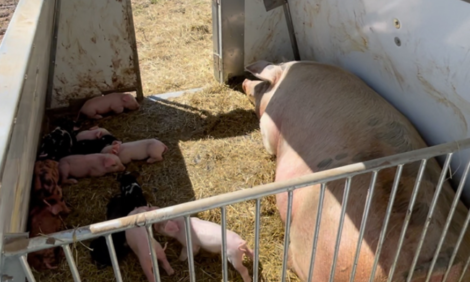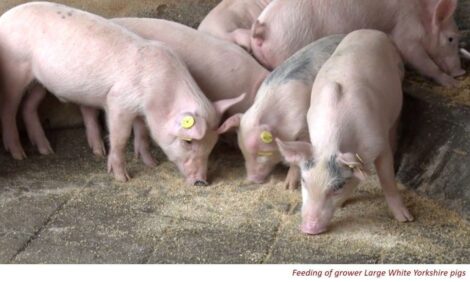



United Kingdom Pig Meat Market Update - February 2011
James Park, senior economic analyst with AHDB Meat Services Economic and Policy Analysis Group, explains the latest trends in the UK and EU.UK Prices
The DAPP declined half a penny in January to below 137p per kilo, two per cent lower than a year earlier. Throughout 2010, the DAPP averaged 142p per kg, almost four pence lower than the average in 2009. Carcass weights in 2010 averaged just above 79kg, almost half a kilo heavier than in 2009. Despite heavier carcass weights in early 2010, probe measurements were largely unaffected compared with year-earlier performance although in the second half of the year, probe measurements increased as carcass weights reduced.
Weaner prices reduced marginally in January to just below £42 per head, although there was some indication in early February of increased activity within the market and some buoyancy with prices. Throughout 2010, the average weaner price averaged £49 per head, five per cent lower than in 2009.

The dioxin crisis in Germany had a severe knock-on effect on the UK sow market with prices dropping to 74p per kg. Despite prices recovering to almost pre-crisis valuations, sow quotations at the start of February were some 16 per cent lower than in 2010 and 31 per cent lower than in 2009. The German market price for sows decreased dramatically in January with at least 15 per cent coming off the sow value in the first three weeks of the year. Consumer demand in January reportedly dropped 10 per cent compared with a year earlier. With Germany being a major consumer of pig meat the knock-on effect throughout the European market has been marked.
Exchange Rates and EU Prices
The European pig reference price was affected by the situation in Germany in the middle of January although by 6 February there was some recovery in Germany, Spain and the Netherlands.

Despite the UK reference price decreasing by one per cent in the four weeks to 6 February in sterling terms, the exchange rate effect resulted in the UK price, in euro terms, decreasing three per cent in the same period. As a result, on 6 February, the premium which UK pig prices exert on the EU average had declined to marginally less than €15 per 100kg, down from the 2010 average of €20 per 100kg.
As of 4 February, applications for approximately 51,000 tonnes of pig meat were estimated to have been lodged under the Private Storage Aid (PSA) scheme according the UECVB following the introduction of PSA on 1 February to support the market.
UK Slaughterings and Production
December 2010 was a five-week month to complete a 53-week statistical year, which makes comparison with previous months and years more challenging. However, in the 53 weeks of 2010, over 9.4 million clean pigs were slaughtered in the UK. Heavier carcass weights resulted in increased production of pig meat to 774,000 tonnes in 2010.
Over 77 per cent of pigs killed in the UK were killed in England and Wales during 2010, a reduction from 78 per cent in 2009. Over 17 per cent were killed in Northern Ireland, an increase from 15 per cent. The proportion of UK pigs killed in Scotland reduced from seven per cent in 2009 to six per cent last year.
The number of pigs killed in Northern Ireland in 2010 increased by 15 per cent to 1.6 million head.
In the final quarter of 2010, the average weekly kill was 187,000 head, 5,000 head more per week more than in the corresponding period a year earlier.

Reports indicate that sow slaughterings increased in the final half of 2010, predominantly as a result of higher feed costs. This will have been coupled with an increased replacement rate which was reflected in the June census data.
During the first 11 months of 2010 almost 330,000 tonnes of fresh, chilled and frozen pork product was imported to the UK, one per cent less than in the same period in 2009. Denmark remained the main supplier of fresh and frozen pork to the UK in the period although imports were down five per cent. The Netherlands on the other hand increased shipments to the UK by 27 per cent to 60,000 tonnes.
The volume of bacon imported to the UK decreased by three per cent to 281,000 tonnes in the first 11 months of the year. A similar pattern existed with Denmark supplying less product than a year earlier whilst the Netherlands and Ireland increased their supplies. Almost 595,000 live pigs were imported to the UK between January and November, 36 per cent more than in the same period in 2009. Almost 99 per cent of the live pigs were imported from Ireland.
Despite the appreciation of sterling during 2010 the export trade was very resilient. Exports of fresh, chilled and frozen pork increased 29 per cent to 121,000. Germany was the major destination for UK pork exports and accounted for 31,000 tonnes. The Netherlands and Ireland were both supplied with over 24,000 tonnes of product.
Exports of bacon and offals increased strongly by 13 and 25 per cent, respectively. The volume of processed products exported decreased by 18 per cent but only accounted for less than 15,000 tonnes.
Feed Prices

China reported increased imports of Australian feed wheat due to a discount compared with US feed wheat. This surprise move was in contrast to the expected increase in Chinese purchases of US maize. The Australian wheat crop, despite being 3.1 million tonnes higher than a year ago at 25 million tonnes, has seen quality downgraded due to higher yields, drought and floods. Increased imports by China are likely to continue with restrictions imposed on the domestic market in an attempt by the Chinese Government to control domestic food price inflation.
Global maize stocks were reported at 120 million tonnes, 14 per cent higher than global demand, offering the market a continued upside. In the UK, East Anglia delivered feed wheat was quoted at £196 per tonne in mid-January.
CBOT soyabean futures prices remained firm entering the final third of January, with price movements more moderate than the price rallies earlier in the month. Crops in Argentina were hampered by challenging weather and also from domestic market restrictions. In mid-January nearby soybean futures prices increased $2.11 per tonne in a week with profit taking a main trading feature. Participants reduced their risk exposure in the market on reports that beneficial rains in Argentina are very likely to help relieve drought conditions and new crop soyabeans are soon to enter export markets from Brazil. But spill-over support from maize and bullish underlying supply concerns proved supportive to prices.
In terms of direct effects on pig producers the ex-farm feed wheat and barley prices recorded further increases in December. Over the course of the 12 months to December feed wheat and barley increased considerably by 82 and 98 per cent, respectively. Soybean meal rations during the year increased by 15 per cent, with £50 per tonne increase in December alone. With the Argentinean situation affecting world prices the January report is unlikely to offer better reading.
AHDB estimates the cost of pig production to be 164p per kg (including finance costs and depreciation) for January as a result of the high grain prices affecting the overall input costs for the industry. Combined with early January DAPP figures the net loss for the industry increased to 27p per kg, more than £21 per pig.
Consumption
In the four weeks ended 23 January 2011, purchases of pork declined one per cent compared with a year earlier although bacon purchases increased four per cent in the same period. For all fresh and frozen meat, there was a six per cent decline year-on-year in the four-week period although prices are marginally higher than at the same time in 2010.
Over the course of the 52 weeks ended 23 January, the quantity of fresh and frozen meat purchased increased two per cent with pork and bacon purchases increasing two and six per cent, respectively.

February 2011






